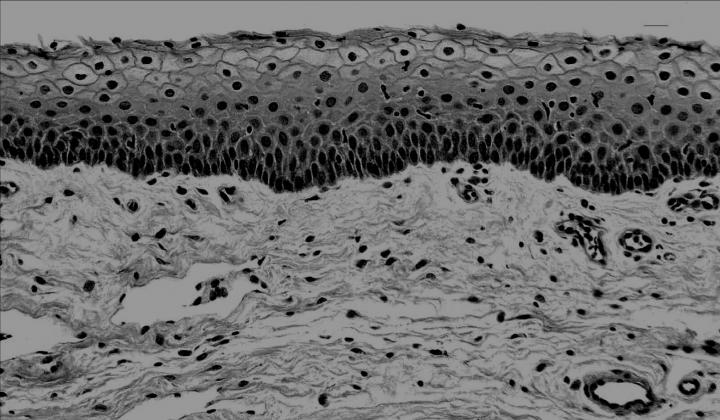Blocking bacteria-molecule interaction might prevent many deadly illnesses

Credit: Patrick Schlievert, Ph.D., University of Iowa Carver College of Medicine
A new study identifies a single molecule as a key entry point used by two types of dangerous bacteria to break through cellular barriers and cause disease. The findings, published March 19 in the journal mBio, suggest that blocking the interaction between the molecule, known as CD40, and bacteria may represent a universal strategy for preventing life-threatening illnesses, including toxic shock syndrome.
The two bacteria, Staphylococcus aureus (staph) and Streptococcus pyogenes, cause many serious illnesses. According to the Centers for Disease Control and Prevention, staph causes 70,000 cases of highly fatal pneumonia, 40,000 cases of severe heart infections, and over 500,000 post-surgical infections each year. Streptococcus pyogenes causes 10 million cases of sore throat and 30,000 cases of severe invasive diseases annually.
“Many of the infections caused by these two bacteria start on the skin or on the mucosal surfaces that line body cavities like the nose, mouth and throat, the gut, and the vagina. The ability of these bacteria to cause disease depends on production of a family of toxins known as superantigens, which cause exceptionally harmful inflammation,” explains Patrick Schlievert, PhD, professor and head of microbiology and immunology at the University of Iowa Carver College of Medicine and lead author of the new study.
Previous work by Schlievert showed that superantigens cause the epithelial cells of the mucosal barrier to make signaling molecules called chemokines. Those chemokines attract immune cells that disrupt the integrity of the mucosal barrier, allowing the superantigens and frequently the bacteria themselves to penetrate and cause serious and often fatal diseases, including toxic shock syndrome.
In the new study, Schlievert and his colleagues at the UI and National Jewish Health in Denver used human vaginal epithelial cells as a model of a mucosal barrier. They showed that the interaction between CD40 and superantigens triggers the production of chemokines in these cells. Removing CD40 from the cells using CRISPR gene editing prevented bacterial superantigens from triggering the production of the chemokines. In contrast, restoring CD40 to those cells restored the ability of superantigens to trigger chemokine production.
The team tested three superantigens: toxic shock syndrome toxin 1 (TSST-1), and staphylococcal enterotoxin B and C. Of the three, TSST-1 produced the strongest effect, which likely explains why this superantigen is responsible for all cases of menstrual toxic shock syndrome.
“CD40 is critical; you get no response (to the superantigens) without it,” Schlievert says. “Since we now know that these two large families of bacteria cause disease through the same human tissue receptor, we are looking for ways to block the interaction between CD40 and superantigens to prevent immune activation. This work also raises the possibility that many other pathogens may cause diseases through the same receptor interaction. Those studies are underway.
“If there is a central pathway that many pathogens use to disrupt mucosal barriers, that would mean we have a single target to block to prevent barrier disruption by pathogens. That could be huge,” he adds.
###
In addition to Schlievert, the research team included UI researchers Michael Cahill, Bruce Hostager, Aloysius Klingelhutz, Francoise Gourronc, and Gail Bishop; Amanda Brosnahan at the University of Minnesota; and Donald Y. M. Leung at National Jewish Health in Denver.
The study was funded in part by grants from the National Institutes of Health.
Media Contact
Jennifer Brown
[email protected]
Original Source
https:/
Related Journal Article
http://dx.




